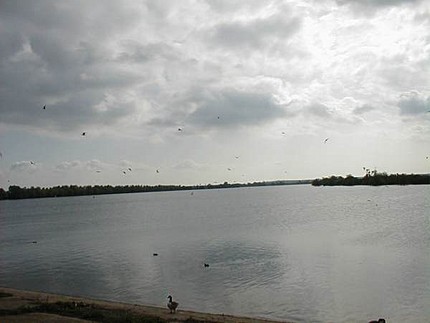The Reservoir
Abberton reservoir, built in the late 1930s as the demands of housing and industrial development in Essex began to outstrip the capacity of local boreholes, covers more than 1,600 acres which included at least one Layer de la Haye farm, Layer House, and the road to Peldon from the eastern boundary of the village.
Eleven miles in circumference, it takes its water mainly from the River Stour, through pipes by pump and gravity feed via underground storage at Ardleigh, though some water is abstracted from the Roman River.

The purpose of the reservoir was and is, to provide water to heavily populated areas of south east Essex, but from the outset it was clear that, located as it was in relation to the east coast estuaries and the Low Countries, it would become a natural resting place for migrating wildfowl on their way to and from the breeding grounds of northern Europe, and an attractive habitat for a wide variety of other birds.
The interest of the Wildfowl Trust was formalised in 1949 when, with the co-operation of the South Essex Waterworks Company, as it was then called, a ringing station was set up for the study of wild ducks, but it was not until 1967 that, at the request of the company, an Order was placed on Abberton Reservoir and its surrounding land creating it a Wild Birds Sanctuary.
Other acknowledgements of the ecological significance of the reservoir have followed - its designation as a Site of Special Scientific Interest, and as a Wetland of International Importance under the terms of the Ramsar Convention.

The interest is not hard to understand in view of the enormous numbers and variety of birds which use the reservoir during the course of a year, as migration stopover or a seasonal or permanent home.
As many as 10,000 wigeon normally winter there, more than 7,000 coots have been recorded there in the summer months, and some 120,000 ducks have been ringed there over the years as part of a study of their breeding and wintering habits, populating levels and migration routes. It is recorded that many of these rings have been returned from abroad, for example those from a tufted duck coming from as far away as the north-west frontier of India, and from a pintail from Senegal, West Africa.
The reservoir is also a place favoured by hundreds of mute swans during the summer for their moulting period. In 1988, 800 were counted, during a time when the exceptionally high water deprived them of access to their weed food and a catastrophe was averted only by reservoir keeper John Gamble feeding them with corn supplied by the company.
Mostly, though, the water and the envirnment provide an ideal habitat for bird life, as the variety of visitors and residents shows.
A one-hour static count undertaken in 1990 by volunteers recorded 41 varieties of bird including Canada geese, coot, great crested grebes, moorhens, dunnocks, pheasant, greenfinch, common sandpiper, grey wagtail, linnet, mute swans, reed bunting, Muscovy duck, greylag, gadwall, barnacle kingfisher, little grebe, turtle dove, mallard, pochard, various gulls, Egyptian goose and emperor goose.

Many other varieties can be seen there during the course of a year and there is also a reasonable chance of spotting something less usual - a kingfisher, or heron, for example, and in 1989 a red-footed falcon caused a stir among local bird watchers.
The reservoir was also one of the first sites at which cormorants were seen forsaking their coastal cliff nesting sites for inland trees. Today, more than 200 pairs nest there, their habitat characterised by the bare trees killed by their droppings.
The main attraction for the cormorants is the generous supply of fish in the reservoir which, though never stocked, holds bream, perch, pike and rudd, and the cormorants get little competition from anglers whose numbers are severely restricted.
A popular feature of the reservoir is the bird hide and picnic spot - soon to be developed further - on the Wigborough road. The hide provides a rare opportunity to observe a colony of terns nesting and rearing their young - this year 23 pairs.
The hide was created by the late Major-General C.B. Wainwright of Layer de la Haye, a birdwatching enthusiast who made a great voluntary contribution to the creation of the bird sanctuary.

Among those who supported him, and were present at the formal opening of the hide was the late Sir Peter Scott. A stone commemorating General Wainwright's contribution to the bird sanctuary is sited at the entrance to the hide.
The reservoir is not, however, a place of interest only to the enthusiastic and knowledgeable bird watcher. Children gain their first knowledge of wildfowl whilst feeding the ducks, adults go there to relax and watch, and at dusk, when flocks of geese and ducks arrive it can be a place of some enchantment.

